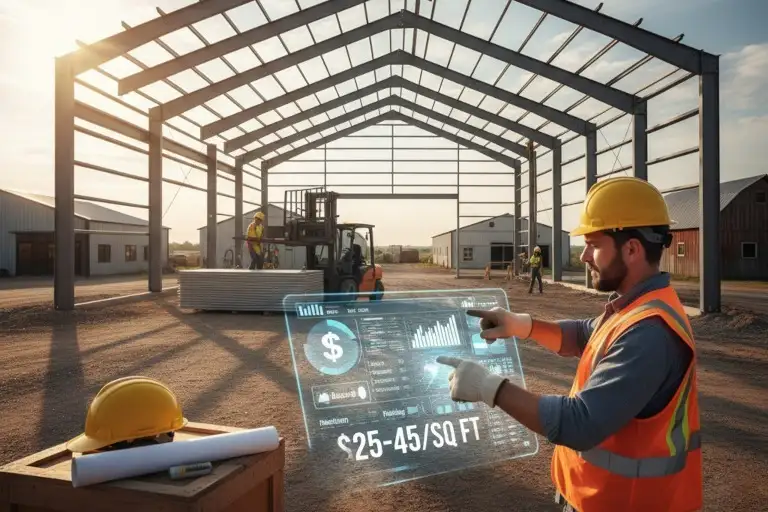Building a metal structure is one of the smartest long-term investments you can make—whether you’re protecting your vehicles, creating a workshop, expanding your business, or storing valuable equipment. But before you begin, one question inevitably rises to the top: “How much does it really cost to build a metal building?”
The honest answer? There is no single number. The true investment required for your metal building depends on a carefully balanced combination of structural design, geographic location, local building codes, climate conditions, and your specific functional needs.
At Steel Building Stores, we don’t believe in one-size-fits-all quotes or generic estimates. We believe in precision, transparency, and purpose-built solutions—because your building must perform not just today, but for decades in the unique environment where it stands.

Not all metal buildings are created equal. The fundamental choice between a tubular steel building and a heavy-gauge (red iron) steel building sets the foundation for your entire project.
These use lightweight, pre-fabricated steel tubing for the frame and are ideal for smaller-scale applications like carports, garages, storage sheds, or hobby workshops. They offer fast installation, straightforward assembly, and excellent value for basic shelter needs. However, they have limitations in width, height clearance, and load capacity.
Built with structural I-beams and designed for maximum strength, these are the go-to choice for commercial warehouses, aircraft hangars, agricultural facilities, or any application requiring large clear spans, high sidewalls, or resistance to extreme environmental forces. They require more engineering but deliver unmatched durability and flexibility.
Choosing between the two isn’t just about size—it’s about what your building must endure and how critical its performance is to your operations.
This is where many buyers underestimate the complexity—and where Steel Building Stores adds real value. The same building that performs flawlessly in Arizona may be dangerously under-engineered for Minnesota, Florida, or Oklahoma.
We use detailed regional climate data—including wind speeds, snow loads, seismic activity, humidity levels, and coastal exposure—to ensure every component of your building is engineered for your specific environment.
Consider these real-world examples:
In Florida or coastal Louisiana:
Hurricane-force winds, salt-laden air, and torrential rains demand corrosion-resistant coatings (like Kynar® or Galvalume Plus®), standing seam roofs with concealed fasteners, and reinforced anchoring systems designed to meet High-Velocity Hurricane Zone (HVHZ) standards.
Across Tornado Alley (Oklahoma, Kansas, Texas, Nebraska):
Structures must withstand sudden, extreme wind uplift and flying debris. This requires heavier gauge framing, impact-resistant wall panels, and deep-set anchor bolts engineered for Category EF3+ events.
In mountainous or northern states (Colorado, Wyoming, Maine, Minnesota):
Snow loads can exceed 50+ pounds per square foot. Roofs must be designed with proper pitch, structural bracing, and snow-shedding geometry to prevent collapse or ice damming.
In arid regions like Arizona or Nevada:
Intense solar radiation and dust storms call for reflective roof colors, airtight seals, and thermal insulation systems that keep interiors cool and protect against abrasive particulates.
Ignoring these regional demands doesn’t just risk structural failure—it can also prevent you from obtaining a building permit or void your warranty and insurance coverage.
A metal building kit is only as good as the engineering behind it. In most U.S. jurisdictions, engineer-certified, state-stamped plans are required by law to obtain a construction permit.
These aren’t optional extras—they’re legal documents that prove your building meets or exceeds local codes for wind, snow, seismic activity, and live loads.
At Steel Building Stores, we provide two types of plans:
Generic Plans (included with every order):
Great for visualizing your layout, dimensions, and door/window placement—but not sufficient for permitting in regulated areas.
Engineer-Certified Plans (available for every state):
Prepared by licensed structural engineers, these include detailed calculations, material specs, foundation layouts, and load ratings tailored to your exact address. They’re essential for compliance, financing, and peace of mind.
Without certified plans, you risk delays, fines, or even being forced to dismantle your structure after installation.
A bare metal shell offers protection from rain and sun—but it’s the accessories and upgrades that transform it into a truly functional space.
Far from a luxury, insulation is critical for:
Options range from economical fiberglass batts to high-performance spray foam—each suited to different climates and uses.
Your access strategy shapes daily usability:
From reflective cool-roof finishes in the desert Southwest to heavy-duty standing seam systems on the Gulf Coast, every detail must align with your climate’s demands. Proper guttering, downspouts, and roof pitch are equally vital to manage runoff and prevent water intrusion.
Remember: your metal building is just one part of a larger project. Additional considerations include:
At Steel Building Stores, we don’t just sell buildings—we guide you through the entire process. From helping you choose the right foundation type to connecting you with trusted local installers, we ensure every phase is coordinated and code-compliant.
The true cost of a metal building isn’t just what you pay upfront. It’s the total value over its lifetime—measured in durability, compliance, energy efficiency, and peace of mind.
A structure that’s under-engineered for your climate might seem like a bargain today—but it could lead to leaks, corrosion, permit denials, or even structural failure tomorrow.
At Steel Building Stores, our mission is simple: to deliver the right building for your property, your purpose, and your place on the map. Not the cheapest. Not the flashiest. But the one that’s engineered to last.
Ready to move forward with confidence?
Contact us today for a personalized consultation—backed by expertise, local knowledge, and a commitment to your success.